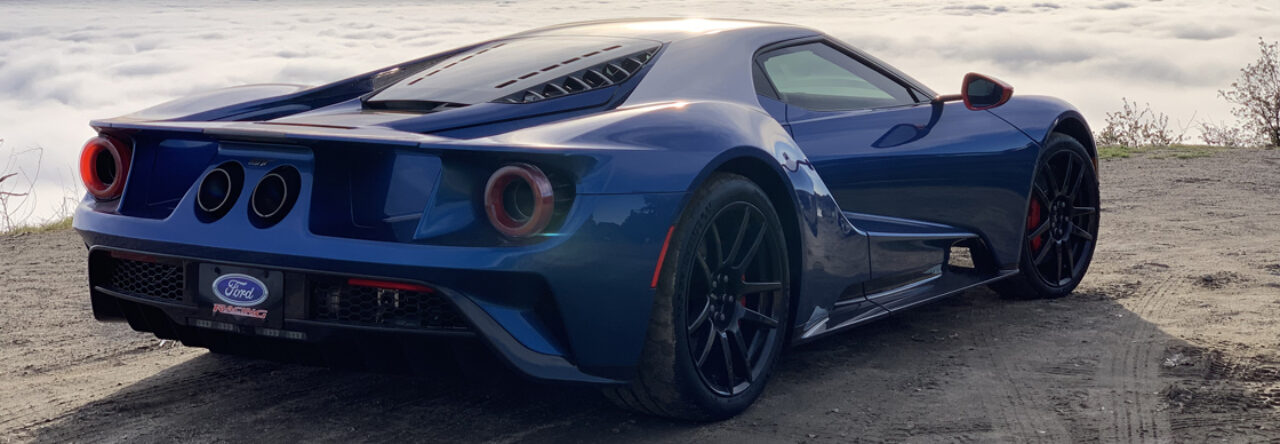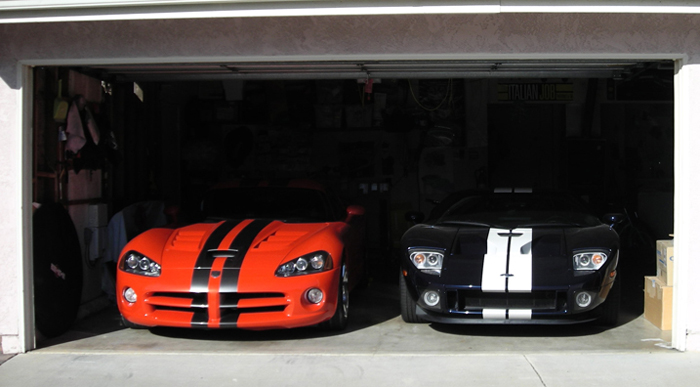How does a 2005 Ford GT stack up against a 2009 Dodge Viper? I had access to both over a weekend and wrote a comparison of the two striped supercars based on performance, ergonomics and the reaction of other drivers. You might be surprised at my final assessment.
September 2010: 2009 Dodge Viper SRT-10 versus 2005 Ford GT
September 3, 2010 at 18,843 miles
Between a 2009 Dodge Viper SRT-10 and a 2005 Ford GT, which one causes a bigger stir when driving among normal cars. It’s a good question, as both vehicles slot into that narrow field of U.S. exotics produced on a limited basis (relatively speaking in the Viper’s case), and both models are now officially out of production.
They’re also both “stripey!”
So if you’re looking to support the home team while enjoying the most “Event-worthy” ownership experience, which American supercar wins? The result may suprise you…
Let’s analyze the major elements that make up an exotic car driving experience and see how they match up:
Head Turning/Crowd Gathering: I’ve had both of these cars parked in my driveway while cleaning them or working on them, and they both cause passersby to stop, stare and often pose questions. The attention the Ford GT draws has almost become passe, so maybe that’s why the Viper’s draw has a bigger impact on me. And maybe it’s the screaming orange color, but the Dodge easily pulls in the locals as effectively as the Ford. I’d almost call this a draw, but I think I have to give it to the Viper (at least in this color). Winner: Viper
Driver Engagement: I’ve often said the Ford GT is a Mustang with poor visibility. That’s not to suggest the Ford GT is simply a glorified pony car but merely to make the point that it’s extremely easy to drive. Basically, if you can handle the demands of driving a Ford Mustang with a manual transmission you can handle the demands of driivng a Ford GT. The Dodge Viper is an entirely different animal. It is not a Dodge Challenger with poor visibility. It’s a cantankerous, loud, fussy attention hog. When you drive it, you’re engaged — whether you want to be or not. And if you relish the engagement it’s pretty rewarding. The GT’s easy-going nature gives the Ford an advantage in terms of being a true gran turismo car (fitting given its name). In terms of driver engagement? Winner: Viper
Performance: There are always two elements to vehicle performance. There’s the statistical, numbers-game element that is easy to record on a spreadsheet. And there’s the more fuzzy aspect relating to everything from steering feel to backside feedback to throttle response and clutch take-up. You can’t easily put numbers on those, but if you’re a true enthusiast they matter as much (or more) than the numbers-game.
On the numbers side, the two cars are pretty close. The Long-Term Ford GT pulled zero-to-60 in 3.7 seconds and the 1/4-mile in 11.8 seconds at 124.4 mph in stock form (it shaved 2/10ths off those numbers with the slight mods we later did, but that doesn’t count because we’re putting it up against a stock Viper). This track tested Dodge Viper pulled zero-to-60 in 3.4 seconds and the 1/4-mile in 11.6 seconds at 125.7 mph. Like most sub-4-second cars the conditions and driver skill make a world of difference when you’re talking tenths of seconds, but suffice to say both are quick and the Dodge appears slightly quicker. The Viper also has an advantage over the last GT we tested in the slalom (74 mph versus 69.5 mph) and braking (107 versus 115 feet).
Stepping beyond the numbers the Viper has the advantage in terms of pure torque because of its increased diplacement and cylinder count, not to mention its normally aspirated engine. But this is offset by the uneven throttle response offered by the snake. It seems Dodge really wanted to protect imprudent drivers from themselves, so the Viper’s throttle tends to feel lazy until you push it past 3/4 travel. Other than torque few would argue the GT’s advantages in terms of steering feel, shifter refinement and overall driver feedback. If the other two categories are close (and they are) this one is razor thin. Winner: Viper
Not everyone’s definition of head-turning style, driver engagement and overall performance is identical, so your results may vary. But as someone who has experienced both cars recently in a variety of conditions the more “Event Worthy” car is the a bright orange 2009 Dodge Viper SRT-10 that can pull crowds and a zero-to-60 time under 3.5 seconds; all while forcing you to pay attention throughout every second of the process.

